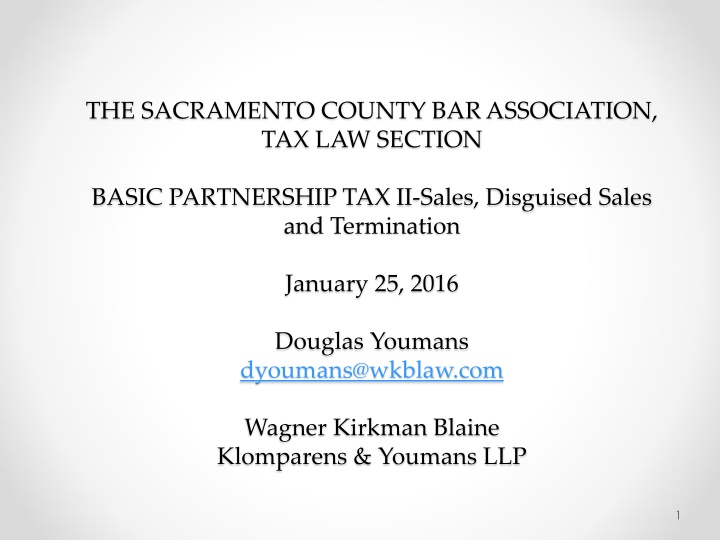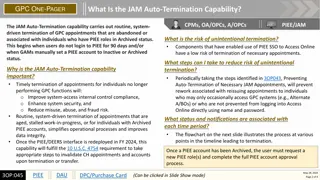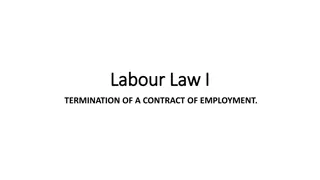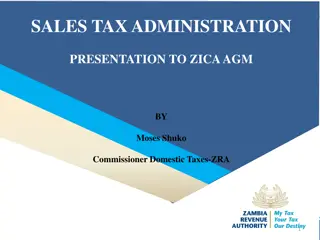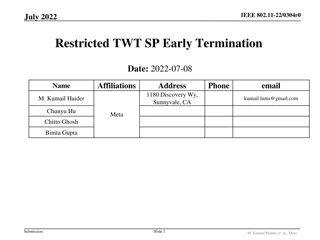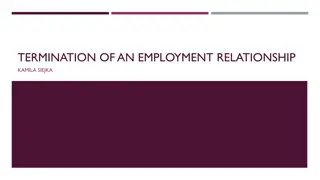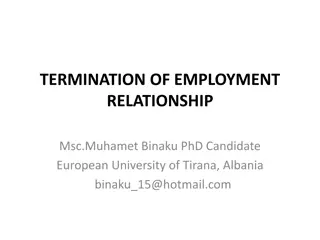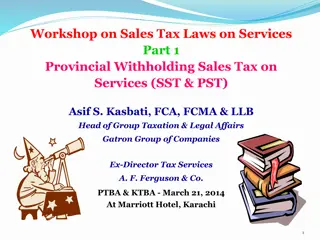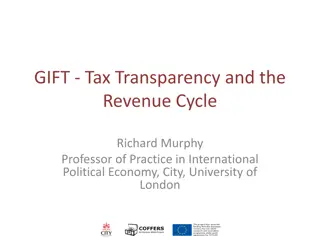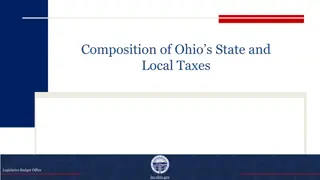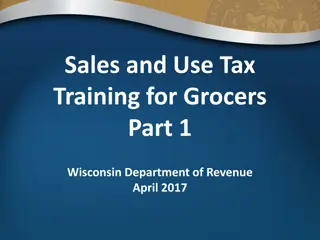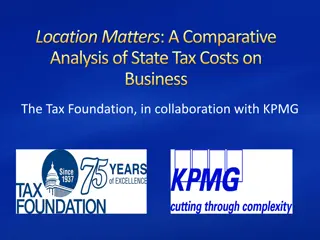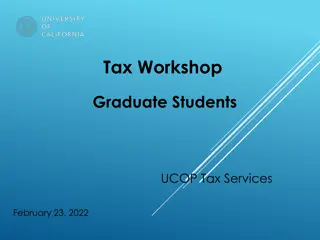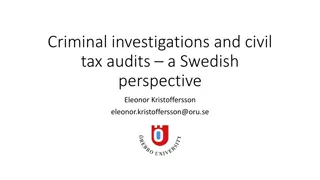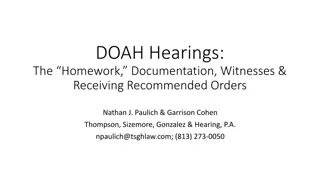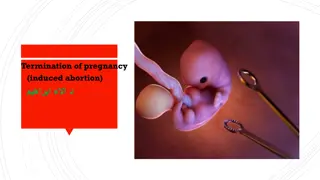Basic Partnership Tax II - Sales, Disguised Sales, and Termination
Basis is crucial in determining tax implications for partnership interests, distributions, and losses. Inside vs. outside basis distinction is key, with outside basis including partnership interest acquisitions and contributions. Understanding varying interests during the tax year is essential for accurate allocations. Explore examples and concepts related to partnership taxation in this informative content.
Download Presentation

Please find below an Image/Link to download the presentation.
The content on the website is provided AS IS for your information and personal use only. It may not be sold, licensed, or shared on other websites without obtaining consent from the author.If you encounter any issues during the download, it is possible that the publisher has removed the file from their server.
You are allowed to download the files provided on this website for personal or commercial use, subject to the condition that they are used lawfully. All files are the property of their respective owners.
The content on the website is provided AS IS for your information and personal use only. It may not be sold, licensed, or shared on other websites without obtaining consent from the author.
E N D
Presentation Transcript
THE SACRAMENTO COUNTY BAR ASSOCIATION, TAX LAW SECTION BASIC PARTNERSHIP TAX II-Sales, Disguised Sales and Termination January 25, 2016 Douglas Youmans dyoumans@wkblaw.com Wagner Kirkman Blaine Klomparens & Youmans LLP 1
REVIEW 2
All About that Basis Basis is important!!! o Basis helps determine the tax consequences of Sales (of partnership interests) Partnership distributions; and Deductibility of partnership (pass-through) losses ( 704(d)) Inside vs. Outside Basis: o Inside: The partnership s basis in the assets in the partnership. o Outside: A partner s basis in his or her or its partnership interest (owned outside of the partnership). 3
Computing Outside Basis A partner s outside basis includes: o Partnership Interests acquired by Purchase: Cost basis, subject to 752 debt assumption and relief. o Partnership Interests acquired by Contributions: Cash contributions by the partner(Including 752 debt assumed ) The contributing partner s basis in any property contributed (FMV is irrelevant); and The amount of gain, if any, recognized by the partner on the contribution. ( 722)
Varying Interests During Tax Year Allocations must take into account varying interests of the partners in the partnership during the taxable year ( 706(d)(1)) Two Methods: o Interim Closing of the Books (Default Method): Partnership allocates items of income or loss as if it had closed its books on the date of the change in ownership (even though its taxable year remains open) o Proration: Partnership determines each partner s share of the partnership s tax items for the year by proration, based on the number of days of the year each respective partner owned the interest which was transferred
Varying Interests During Tax Year (Cont.) Example (Varying Interests): Partnership only engages in 1 transaction, a sale on 2/1, generating $1,000,000 worth of gain. P1 transfers to P2 on 2/2. Who wants to close the books? Who wants to prorate?
(Income) Allocations With Respect to Contributed Property 704(c). A contributing partner must remain responsible for inherent tax consequences in contributed property when unrecognized gains or losses at the time of contribution are subsequently realized by the partnership. o Example: If a partner contributes property with a basis of $4k and a FMV of $10k, upon the partnership s subsequent sale of the contributed property, the contributing partner is allocated the first $6k of the capital gain arising from the sale.
Partnership Distributions: Current or Liquidating? A liquidating distribution: terminates the partner s entire interest in the partnership. (Regs 1.761-1(d).) o May trigger loss recognition to distributee-partner if distribution is less cash than the distributee-partner s outside basis. Unrealized receivables and inventory are treated as cash for this purpose. A current distribution is any distribution which is not a liquidating distribution. 8
Current Distributions: Gain or Loss? General Rule: Nonrecognition of gain or loss to all parties on distribution of partnership property or money to partners ( 731) Losses: A loss is never recognized in a current distribution. Cash Distributions: Distributee-partner reduces their outside basis by amount of money received. ( 733.) o Exception: Cash distribution in excess of distributee-partner s outside basis is taxable gain to distributee-partner. Exception does not apply to property distributions. 9
Current Distributions: Basis Effects Property Distributions: Distributee-partner takes partnership s inside basis in the distributed property and reduces their outside basis by that amount equal to the sum of (i) any money received; plus (ii) the partnership s inside basis in the property distributed. ( 732(a) and 733.) Limitation: Basis in property received by distributee-partner cannot exceed distributee-partner s outside basis immediately prior to the distribution reduced by any cash received in the same transaction. ( 732(a)(2).) o If this limit applies, the distributee-partner s basis in the property distributed is equal to the distributee-partner s outside basis immediately prior to distribution, reduced by any actual or deemed cash received; and their outside basis will be zero. 10
Current Distributions: Basis (Cont.) Example (Current Distribution/Basis): Emily and Scott form E&S as equal partners. Emily receives a current distribution of property from E&S. At the date of distribution, the property has an FMV of $14,000 and an inside basis of $7,500. Immediately prior to the distribution, Emily s outside basis is $12,000. Neither E&S nor Emily recognizes a gain on the distribution. Emily s basis in the property distributed to her becomes $7,500 (i.e., the inside basis of the property to E&S), and her outside basis is reduced to $4,500 ($12,000 - $7,500). Assume, instead, that Emily s outside basis immediately prior to the distribution is $6,000. In this case, Emily s outside basis is not sufficient to match E&S inside basis in the property. Again, neither E&S nor Emily recognizes a gain on the distribution. Upon the distribution, Emily s outside basis is reduced to zero ($6,000 - $6,000), and she takes a basis in the distributed property of $6,000. 11
DISTRIBUTIONS IN COMPLETE LIQUIDATION OF PARTNERSHIP INTERESTS Taxation. Exception to General Rule with Respect to Recognition of Loss: A liquidating distribution may trigger loss recognition to the distributee- partner if the distribution consists of less cash than the distributee- partner s outside basis. Unrealized receivables and inventory will be treated as cash for this purpose. Basis of Property Received in Complete Liquidation of a Partnership Interest The inside basis of property distributed as part of a liquidating distribution is carried over, and increased when the distributee- partner s outside basis (as reduced by any cash or liability reduction as a result of the distribution) is greater than the property s inside basis. A distributee-partner s basis in unrealized receivables and inventory cannot exceed the inside basis in such property. 12
DISTRIBUTIONS IN COMPLETE LIQUIDATION OF PARTNERSHIP INTERESTS Example (Liquidating Distribution/Basis): Emily receives a liquidating distribution of non- 751 property from E&S. At the date of distribution, the property has a FMV of $14,000 and an inside basis of $12,000. E&S has no outstanding liabilities. Immediately prior to the distribution, Emily s outside basis is $7,500. Neither E&S nor Emily recognizes a gain on the distribution. Emily s basis in the property distributed to her is limited to $7,500 (i.e., her outside basis in her partnership interest). Hence, if she sells @ the $14,000 FMV, she will recognize a $6,500 gain. 13
Part I SALES 14
Sales and Exchanges of Partnership Interests General Rule: The amount and character of gain or loss, basis and holding period are based on the partnership interest held by the selling partner and not on the assets owned by the partnership. o Exceptions: Hot assets , collectibles, or 1250 capital gain at the time of the sale. ( 751.) General Rules Transferor/Selling Partner 1. Amount Realized. In determining amount realized under 1001, the partner must include his or her share of partnership debt as a part of the amount realized. ( 752.) 2. Adjusted Basis. In determining his or her adjusted basis, the selling partner must include his or her share of partnership income or loss up to and including the date of sale. 3. Closing the Tax Year of the Selling Partner. Although, under 705, outside basis for income and loss is not generally adjusted prior to the close of a tax year, 706(c) states that the sale or exchange of an entire interest closes the tax year of a partnership (only) with respect to the selling partner. a. 706(c) does not authorize the closing of the partnership's tax year with respect to a partner who sells or exchanges less than his or her entire interest. In such a case, 706(d)(1) requires the partnership and the partners involved to appropriately account for the impact such a sale or change in interest has on basis, capital account, income sharing, etc. 15
Sales and Exchanges of Partnership Interests 4. Selling Partner - Installment Sales Treatment. Partnership interests, like other capital assets, may be sold, with gains thereon reported on the installment method under 453. Under the installment method of accounting, otherwise taxable capital gains are reported as and when principal payments are received on the basis of a gross profit ratio. However, per 453(i)(2), gain on the sale of an interest subject to 751(a) recapture items may not be subject to installment reporting. (See also, Rev. Rul. 89-108 (denying 453 treatment to the extent of 751(a) substantially appreciated inventory items). 5. Hot Assets. To the extent the partnership holds inventory or unrealized receivables (collectively referred to as Hot Assets ), a selling partner's capital gain may be recharacterized as ordinary income. 16
Sales and Exchanges of Partnership Interests General Rules Buying Partner. 1. Adjusted Basis. The purchasing partner acquires a cost (outside) basis in the acquired partnership interest equal to (i) the cash and FMV of property paid to the seller in consideration of the interest; plus (ii) the new partner's allocable share of partnership debt. 2. 754 Considerations. An important consideration to a purchasing partner whose purchase price (outside basis) exceeds his or her underlying share of the basis of partnership assets (inside basis) is whether to demand or request that the partnership elect to adjust its inside basis under 754. 3. Interim Income/Loss Allocations. Just as the selling partner should be concerned with respect to the partnership's determination of interim income and loss for allocation and basis purposes, the incoming partner should also be interested in income and loss allocations for the 2 deemed short periods. 4. Capital Account. The buying partner generally takes the selling partner's capital account without adjustment. 17
Part II DISGUISED SALES
DISGUISED SALES There are three (3) separate disguised sale rules in the Code: A. 707(a)(2)(B), which generally treats a contribution of property followed by a distribution of other property to the same partner in a related transaction which occurs within 2 years (or maybe longer) as a disguised sale with gain or loss being recognized. B. 704(c)(1)(B), which requires recognition of built-in gain to the contributing partner when a contributing partner contributes property with built-in gain and that same property is distributed to another partner within 7 years. C. 737, which complements 704(c)(1)(B) by providing that, if a contributing partner contributes property which has built-in gain and the contributing partner receives a distribution of other property within 7 years, the built-in gain on the original transfer must be recognized by the contributing partner.
707(a)(2) Under 721(a), contributions of property to a partnership are GENERALLY nontaxable events. However, if there is a transfer of property by a partner to a partnership, and a related transfer of money or other property by the partnership to the partner, then the facts and circumstances should be examined to determine whether the events should be regarded as a sale of property by the partner to the partnership. 20
707(a)(2) Facts and Circumstances (Reg. 1.707-3(b)(2)) Timing and amount of subsequent transfer are determinable with reasonable accuracy at the time of earlier transfer; Transferor has a legally enforceable right to subsequent transfer; Partner's right to receive money or other consideration is secured; Any person has made or is legally obligated to make contributions to the partnership, to permit the partnership to make the transfer of money or other consideration; Any person has loaned or agreed to lend the partnership the money or other consideration, to enable the partnership to make the transfer;
707(a)(2) Facts and Circumstances (Reg. 1.707-3(b)(2)) Partnership has incurred or is obligated to incur debt to acquire the money or other consideration, to permit the partnership to make the transfer (considering such facts as whether any person has agreed to guarantee or assume personal liability for the debt); Partnership holds money or other liquid assets beyond its reasonable needs that are expected to be available to make the transfer; Partnership distributions, allocations, or control of partnership operations are designed to effect an exchange of the burdens and benefits of ownership of property The transfer by the partnership is disproportionately large in relation to the partner's interest in partnership profits Partner either has no obligation to return or repay the money or other consideration, or the obligation is likely to become due at such a distant point in the future that the present value of the obligation is small in relation to the money or other consideration transferred by the partnership
707(a)(2) Two-Year Presumptions (Reg. 1.707-3(c)&(d)) > 2 Years If the transfers occur more than two years apart, then they are presumed NOTto be a sale. 2 Years If the transfers occur within a two-year period, then they are presumed to be a sale, unless one of the following 4 exceptions applies: 1. Reasonable Guaranteed Payments 2. Reasonable Preferred Returns 3. Distributions of Net Operating Cash Flow 4. Reimbursements of Preformation Expenses 23
707(a)(2) Exceptions to Presumption of Sale 1. Reasonable Guaranteed Payments for Capital A guaranteed payment for capital is any payment to a partner by a partnership that is determined without regard to the partnership income and that is for the use of that partner's capital. Payments are not treated as being made for the use of a partner's capital if the payments are designed to liquidate all or part of the partner's interest in property contributed to the partnership rather than to a provide the partner with a return on an investment in the partnership. 24
707(a)(2) Exceptions to Presumption of Sale 2. Reasonable Preferred Returns A preferred return is a preferential distribution of partnership cash flow to a partner with respect to capital contributed to the partnership by the partner that will be matched by an allocation of income or gain. (Regs. 1.707-4(a)(2).)
707(a)(2) Exceptions to Presumption of Sale Reasonable Guaranteed Payments and Preferred Returns - Additional Requirements Payments must be pursuant to written provision of partnership agreement. Preferred returns or guaranteed payments for capital are reasonable only to the extent the partnership agreement provides for payment for the use of capital in a reasonable amount, and only to the extent that the payment is made after the date on which that provision is added to the partnership agreement. Payments must not exceed the amount determined by multiplying either the partner's unreturned capital at the beginning of the year or the partner's weighted average capital balance for the year by the safe harbor interest rate for the year (which is 150% of the highest AFR in effect from time when right to payment is first established, through the end of the tax year). 26
707(a)(2) Exceptions to Presumption of Sale 3. Net Operating Cash Flow Net Operation Cash Flow distributions are presumed NOT to be part of a sale. Certain operating cash flow distributions are presumed to not constitute part of a sale of property to a partnership unless the facts and circumstances clearly establish that the transfer is part of a sale. (Regs. 1.707-4(a)(2).)
707(a)(2) Exceptions to Presumption of Sale 4. Preformation Expenditures Reimbursement of Preformation Expenditures are presumed NOT to be part of a sale. Reg. 1.707-4(d) 28
707(a)(2) Exceptions to Presumption of Sale 4. Preformation Expenditures Preformation Expenditures are: o incurred during the 2-year period preceding the transfer by the partner to the partnership and o incurred by the partner with respect to partnership organization and syndication costs or with respect to property contributed to the partnership, but only to the extent the reimbursed capital expenditures do not exceed 20% of the property's FMV at the time of contribution.* * 20% limit doesn't apply if contributed property's FMV 120% of the partner's adjusted basis in the property at the time of contribution. 29
707(a)(2) Disclosure Required Form 8275 A partner must attach Form 8275, Disclosure Statement, to his or her return if: the partner contributes property to a partnership, the partnership transfers money or other consideration to the partner within 2 years before or after the contribution, the partner treats the transfers as something other than a sale, and the transfer of money or other consideration is not presumed to be a guaranteed payment for capital, is not a reasonable preferred return, and is not an operating cash flow distribution. 30
707(a)(2) Disclosure Required Form 8275 The Form 8275 disclosure should include: A caption identifying the statement as a disclosure under IRC 707; A description of the transferred property or money, including its value; and A description of any relevant facts in determining if the transfers are properly viewed as a disguised sale. 31
707(a)(2) Transfers Within 2 Years Example 1 Facts: A transfers property to a partnership in exchange for a partnership interest. Property has a FMV of $4,000,000 and an adjusted tax basis of $1,200,000. Immediately after the transfer, partnership transfers $3,000,000 in cash to A. 32
707(a)(2) Transfers Within 2 Years Example 1 Tax: A sold a interest in the property and contributed a interest $3,000,000 cash distributed to A for property worth $4,000,000 ($3,000,000 or of the transaction treated as a sale) A contributed property with a FMV of $1,000,000 and an adjusted basis of $300,000 (1/4 of $1,2000,000) to partnership for a partnership interest. A s outside basis in her partnership interest will be $300,000. 33
707(a)(2) Liabilities Qualified Liabilities - If a partnership assumes (or takes property subject to) a qualified liability , the partnership will not be treated as having transferred consideration to the partner pursuant to a sale, provided the transaction is not otherwise treated as part of a sale. 34
707(a)(2) Qualified Liabilities (Regs 1.707-5(a)(6)) A liability is a Qualified Liability to the extent the liability: was incurred more than 2 years prior to the earlier of the date the partner agreed to transfer the property or the date the partner transferred the property to the partnership, and has encumbered the property throughout the 2-year period, or was not incurred in anticipation of the transfer to the partnership, or is allocable to capital expenditures with respect to the property, or was incurred in the ordinary course of business, but only if all of the assets related to the business are transferred other those that are immaterial to the continuation of the business. 35
707(a)(2) Qualified Liabilities Example 2 Facts: A transfers property to a partnership FMV is $165,000; Basis is $75,000; Liability of $75,000 is incurred more than 2 years before transfer, secured by the property since incurred Assume liability becomes a partnership recourse liability & that A's share is $25,000 36
707(a)(2) Qualified Liabilities Example 2 Tax: This is a qualified liability. Since no other transfer was made to A as consideration for the transfer of the property, the partnership s assumption of the liability is not treated as part of a sale. 37
707(a)(2) Non-qualified Liabilities If a partnership assumes (or takes property subject to) a non-qualified liability, the partnership will be treated as having transferred consideration to the partner pursuant to a sale to the extent responsibility for the liability is shifted to another partner. 38
704(c)(1)(B) Prior Law (Part of the Review ) Under 704(c)(1)(A), a partner contributing property with a built-in-gain or loss to a partnership is generally allocated that gain or loss when the partnership subsequently disposes of the property. Prior to the enactment of 704(c)(1)(B), a contributing partner could avoid an allocation of precontribution gain or loss if the partnership distributed the contributed property to another partner rather than selling it. 39
704(c)(1)(B) Current Law If property contributed by one partner has built-in gain and that property is distributed to another partner within 7 years of its contribution, the contributing partner (or his or her successor) is treated as recognizing 704(c) built-in gain or loss as if the partnership had sold the property for its FMV at the time of the distribution. The contributing partner s outside basis is increased or decreased by the amount of gain or loss recognized as a result of the distribution. To avoid double recognition of that gain or loss, the partnership s inside basis in the property is increased or decreased PRIOR to the distribution (to reflect the gain or loss recognized by the contributing partner). This rule applies to contributing partners and their successors. Thus, if a contributing partner transfers a partnership interest, following which the partnership distributes the contributed property to a partner other than the transferee, the transferee recognizes the gain that would have been allocable to the transferor ( 704(c)(3)). 40
704(c)(1)(B) Recognition of Gain and Basis Adjustment Under 704(c)(1)(B) Example 3 Facts: A contributes Blackacre with an adjusted basis of $12,000 and a FMV of $20,000 B contributes $20,000 cash. 3 years later the partnership distributes Blackacre, then worth $23,000, to B. 41
704(c)(1)(B) Recognition of Gain and Basis Adjustment Under 704(c)(1)(B) Example 3 Tax: Under 704(c)(1)(B), A is allocated the $8,000 (20,000 12,000) precontribution gain just as if the partnership had sold the property instead of distributing it. A would increase his or her outside basis by $8,000 (to $20,000). Partnership s inside basis in Black acre is increased to $20,000 (12,000 + 8, 000) prior to the distribution. Blackacre s basis in B s hands would be $20,000. 42
704(c)(1)(B) Character of Gain or Loss: Capital or Ordinary Rule: The character of this gain or loss is determined as if the partnership sold the property to the distributee. Thus, ordinarily the character of the gain or loss will be determined by the character of the property in the hands of the partnership. Recharacterization rules such as IRC 707(b)(2) may apply, however, to convert capital gain to ordinary income. 43
704(c)(1)(B) Exceptions Exception #1: Property Distributed to Contributing Partner 704(c)(1)(B) does not apply if the contributed property is distributed back to the contributing partner. 44
704(c)(1)(B) Property Distributed to Contribution Partner Example 4: A contributes Blackacre with an adjusted basis of $12,000 and a FMV of $20,000. B contributes $20,000 cash to the equal AB partnership. 3 years later, the partnership distributes Blackacre, then worth $23,000, back to A. Since A is the contributing partner, 704(c)(1)(B) does not apply. 45
704(c)(1)(B) Exception #2: Distributions that Would Otherwise Qualify for Like-Kind Treatment 704(c)(2) provides relief to a contributing partner who receives a distribution of like-kind property (within the meaning of 1031) within 180 days after the contributed property is distributed to another partner. The policy is that the contributing partner should not have to recognize gain under 704(c)(1)(B) if he would have qualified for nonrecognition if the transaction had taken place outside the partnership. 46
704(c)(2) PARTNERSHIP WHITE ACRE BLACK ACRE PARTNER B PARTNER A 1031 BLACK ACRE Partner A PARTNER B WHITE ACRE 47
704(c)(1)(B) Other Exceptions Distributions of Contributed Property will Not Trigger Gain or Loss in the Case of: Contributions before effective date. Property contributed on or before October 3, 1989 (Reg. 1.704-4(c))1)). Certain liquidations. A distribution of an interest in contributed property to a partner in liquidation of the partnership if (1) the contributing partner receives an interest in the contributed property (and no other property) and (2) the built-in gain or loss in the interest distributed to the contributing partner is equal to or greater than the built-in gain or loss that would have been allocated to that partner on a sale of the property immediately before the distribution (Reg. 1.704-4(c)(2)). Termination. A deemed distribution caused by a termination of the partnership under 708(b)(1)(B) (Reg. 1.704-4(c)(3)). 48
704(c)(1)(B) Other Exceptions (cont d.) Distributions of Contributed Property will Not Trigger Gain or Loss in the Case of: Tiered partnership transaction.A partnership that transfers all of its assets and liabilitiesto a second partnership (transferee partnership) in an exchange described by 721, followed by a distribution of the interest in the transferee partnership in liquidation of the transferor partnership as part of the same plan or arrangement (Reg. 1.704- 4(c)(4)). Incorporation. Incorporation of a partnership, provided that the partnership is liquidated as part of the incorporation transaction (Reg. 1.704-4(c)(5)). However, if the partnership distributes its property to the partners, following which that property is contributed to a corporation, this exception does not apply. Undivided Interests. Distribution of an undivided interest in property, to the extent that the undivided interest does not exceed the undivided interests, if any, contributed by the distributing partner in the same property (Regs 1.704-4(c)(6)). 49
704(c)(1)(B) Anti-Abuse The Regs under 704(c)(1)(B) also contain an anti-abuse provision under which the statute and Regs must be applied in a manner consistent with the purpose of the section, or the Service can recast a transaction for federal tax purposes to achieve appropriate tax results. For example, the Regs apply 704(c)(1)(B) to a distribution that actually takes place after the statute s time limitation (i.e., more than 7 years after the contribution of property), but where the partners took steps that were the functional equivalent of a distribution before the end of that period. 50
